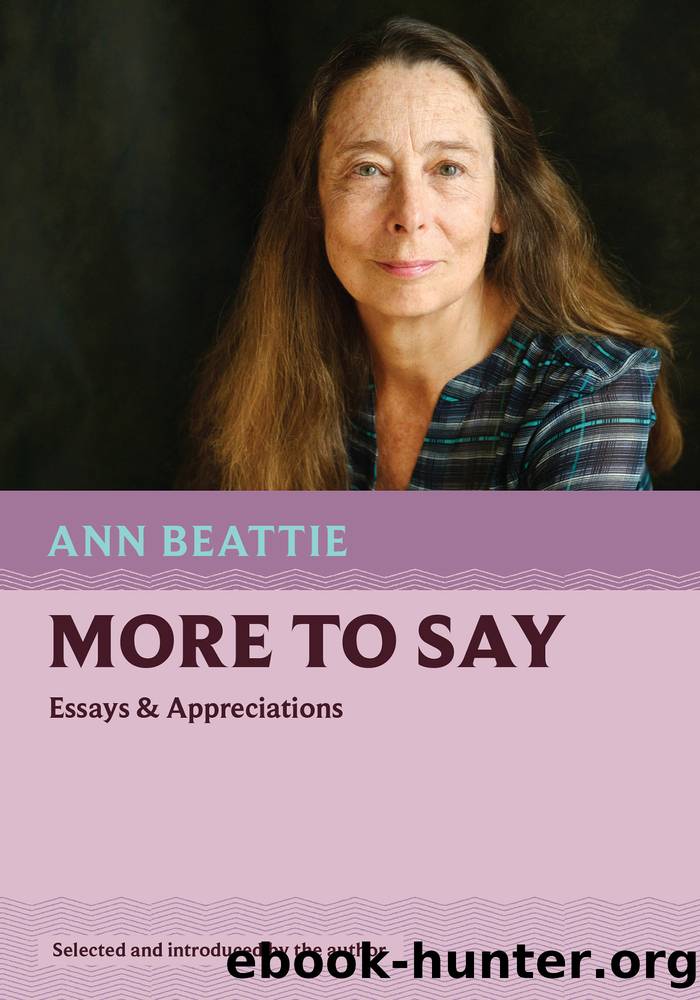More to Say by Ann Beattie

Author:Ann Beattie
Language: eng
Format: epub
Publisher: David R. Godine, Publisher
Published: 2023-08-15T00:00:00+00:00
Sometimes, those times I can get on another writerâs wavelength, I can point to a sentence, or an individual word, and identify the writerâs turning point, say exactly where they decided not to tell the storyâ âto make it one story, versus another. This isnât a unique skill. Writing an alternate story doesnât make it better or worse than the one unwritten. But sometimes the writer doesnât realize that theyâre hiding in plain sight, or that theyâve failed to smooth things over enough that theyâre entirely convincing; they might be dressed well, but the hem is showing. I feel Freudâs spirit hovering as I say that. Itâs also possible that, until itâs pointed out, the writer doesnât âseeâ whatâs there.
Neither is true of two other writers I want to mention briefly, though both have decided to reveal whatâs at stake, or what most matters, early in their storiesâ ânot to hide it at all, but to draw attention to it. Itâs amazing that when this happens, the reader registers it but keeps on readingâ âonly to find that what was always there returns in an unexpected way, familiar yet different, because of the story thatâs developed between its revelation and the storyâs end. Russell Banks, in âSarah Cole: A Type of Love Story,â creates a first-person narrator who states an important fact early in the story, though by the time that information reappears, he also reveals that the confession has been a ruse. In Frank Conroyâs âMidair,â an essential traumatic scene is enacted, but the character himself forgets, repressing it. Then, at storyâs end, provoked by what were related yet random occurrences, the memory is recovered. The cracks in the sidewalk that were first seen by the young son whose father endangered him (and his sister) by crazily taking them out on a ledge high above the pavement, from which they looked down, are seen again at storyâs end, but this time they mean something different (as so many things do that we see in childhood, then later as adults); the cracks now also exist the way cracks do in storiesâ âso that among the endingâs many levels of meaning, it reminds the reader that stories are artifice at the same time they intend to be simultaneously real. In Conroyâs story, tension exists between the readersâ knowledge that leads to their understanding of the character, while the character goes through his life knowing less than we do, existing at a distance from himself. Itâs become such a convention for writers to invoke unreliable narrators that the reader can be surprised if the narrator is reliableâ âbut Banksâs story and Conroyâs are doing something different, and in a way, the reader becomes the third side of the triangle, implicated (as we become exiled bystanders in Carverâs story âNeighborsâ) but powerless. In âSarah Coleâ and âMidair,â the characters wish to be in control, they pass for being in control; itâs easy to imagine they might answer any questionâ âthey might even turn their pockets inside out to show
Download
This site does not store any files on its server. We only index and link to content provided by other sites. Please contact the content providers to delete copyright contents if any and email us, we'll remove relevant links or contents immediately.
David Busch's DJI Mini 3Mini 3 Pro: Guide to Drone Photography by David D. Busch(428)
Photography Week by No. 624(377)
Simplified Adobe Photoshop Lightroom Classic For Beginner Photographers (2022 Edition) by Grant Antonio & Grant Antonio(352)
Male Nude by Jon Sargent(298)
You Will Be Able To Take Great By The End Of This Book by Benedict Brain(280)
A Photographic Journey Through the London Underground by Elke Rollmann(222)
How to Create a Successful Photography Business by Elizabeth Etienne(214)
Lightspeed Magazine, Issue 104 (January 2019) by John Joseph Adams(207)
Social Media Selfie: A Complete Guide to Posing for Social Media Models and Photographers by Julian Mason(202)
Lightspeed Magazine, Issue 113 (October 2019) by John Joseph Adams(202)
How to Take Better Photos by Justin Whiting(202)
Photoshop Practical Course: Accelerated Initiation to Image Design and Editing by Ernesto Martinez(200)
The Complete Guide to Sony's Rx-100 Iii by Gary Friedman(187)
Read This if You Want to Take Great Photographs of Places by Henry Carroll(183)
Captured: Lessons from Behind the Lens of a Legendary Wildlife Photographer by Moose Peterson(179)
Activist by KK Ottesen(175)
Canon EOS Rebel SL1100D For Dummies by Doug Sahlin(174)
Cinema and Colour by Paul Coates;(172)
Beginner's Guide to Digital Painting in Procreate: A Step by Step Guide to Create Art on an iPad Pro for Novice and Pro by Stiner Jonathan(171)
